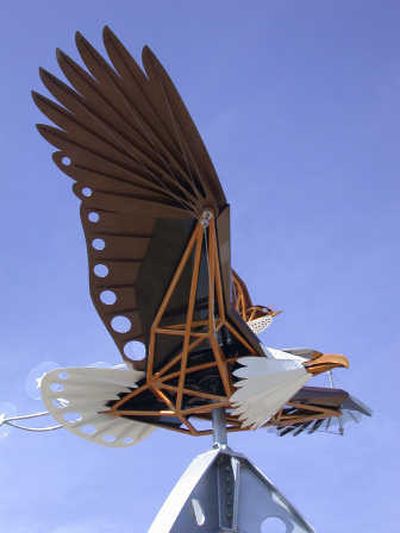Sculptor puts art in motion

When he was a child, artist Miles Pepper learned a Native American story about an eagle and a thrush working together to retrieve beautiful music coming from the heavens.
Pepper, a Pullman sculptor, used that legend as inspiration for creating a moving metal sculpture installed two years ago at Michael Anderson Elementary School at Fairchild Air Force Base.
The eagle is a quintessential American symbol, and the piggyback ride the eagle gave the thrush in the native story seemed like a fitting parallel to the life of the space shuttle astronaut who was killed during a re-entry failure in 2003 and honored with the school name at Fairchild, Pepper said.
The piece at Anderson Elementary School is among more than a dozen public pieces of artwork throughout the Pacific Northwest. Pepper’s unique sculptures adorn some of the region’s most important public places, including Portland International Airport and the Oregon Zoo in Portland.
An exhibit based on photographs and models of his work is currently on display in the Chase Gallery at Spokane City Hall.
“When I was growing up, mobiles were a big thing,” Pepper said during an interview at the gallery last week.
Pepper’s sculptures are designed to fly with the wind, making motion an inseparable component of their beauty.
The eagle and thrush sculpture features an eagle with a 16-foot wing span that turns into the wind to fly. The strength of the wind moving across the sculpture forces the eagle’s wings to sweep backward. The piggybacked thrush is mounted independently to fly on its own.
“I think I’ve always found a sense of joy in movement,” Pepper said.
Born in North Dakota, Pepper was raised in California where he went to college. He studied metallic arts at a junior college and moved to Pullman in 1992 where he earned a master’s degree in art. While working on his degree, he was introduced to the engineering shop in the school of architecture where he learned more about working with metals. Pepper was recently hired to supervise the shop. He’s been making public art sculptures since 1995.
In his work, he uses sheet aluminum, which he welds or rivets into place. By using counterweights, shafts and bearings, Pepper builds the sculptures to move in the wind. The piece at the Portland airport, which is based on historic flight machine drawings by Leonardo da Vinci, extends through a roof so that it has moving elements both outdoors on top of the roof and indoors below the ceiling.
His technique for finishing the metal with a grinder creates the impression of feathers or scales by reflecting the light in different directions. The sculptures may be coated with an acrylic finish that’s applied as powder and then baked onto the metal.
“They are complicated pieces,” Pepper said.
They are not cheap. The sculptures often cost more than $100,000.
At a Moscow, Idaho, fire station, Pepper completed a 22-foot-tall column that looks like an antique fire nozzle shooting water upward. Within the water stream is the cutout of firefighter.
At two light rail stations in the Hillsboro, Ore., area, Pepper created a scarecrow and seed head sculpture and another one of swallows to evoke the history of family farming in the area.
The modernistic Beacon Hill Branch Library in Seattle has “Dream Boat” mounted on a mast-like structure as well as raven’s bill downspouts that spill water off the roof.